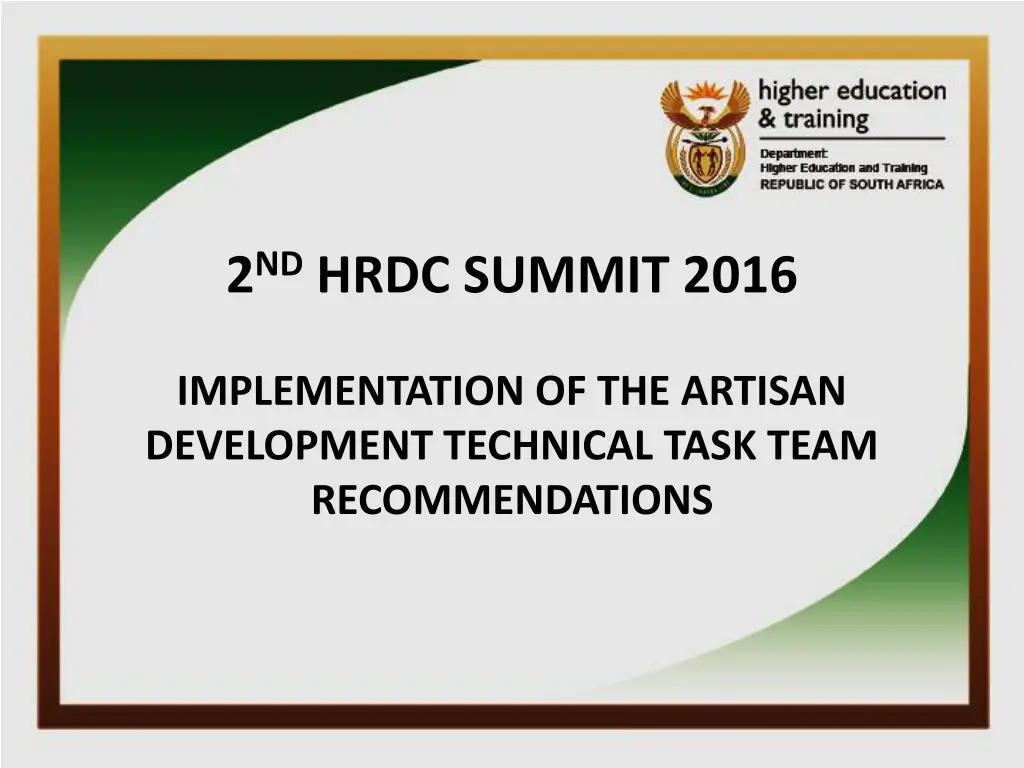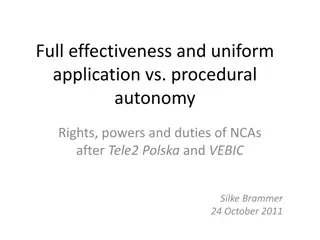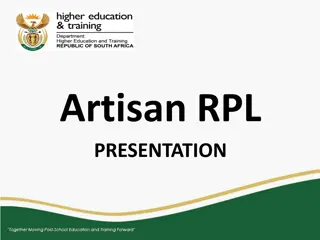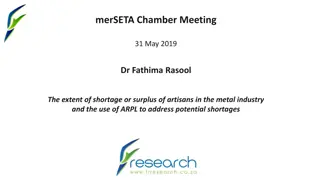
Implementing Artisan Data System for Development Summit Recommendations
"Explore the implementation of artisan data system to address trade prioritization challenges with detailed data collection, collation, analysis, and reporting. Learn about the progress and challenges in the artisan industry. Enhance skills planning and projections for artisans through intelligent data structuring. Engage with the AG scrutinized data for accurate supply-demand analysis."
Download Presentation

Please find below an Image/Link to download the presentation.
The content on the website is provided AS IS for your information and personal use only. It may not be sold, licensed, or shared on other websites without obtaining consent from the author. If you encounter any issues during the download, it is possible that the publisher has removed the file from their server.
You are allowed to download the files provided on this website for personal or commercial use, subject to the condition that they are used lawfully. All files are the property of their respective owners.
The content on the website is provided AS IS for your information and personal use only. It may not be sold, licensed, or shared on other websites without obtaining consent from the author.
E N D
Presentation Transcript
2NDHRDC SUMMIT 2016 IMPLEMENTATION OF THE ARTISAN DEVELOPMENT TECHNICAL TASK TEAM RECOMMENDATIONS
1stBLOCKAGE PROBLEM STATEMENT Detailed, accurate and current artisan data for trade prioritization not available. SOLUTION Develop and implement policy and system on artisan data collection, collation, analysis and reporting.
SYSTEM 2012 2013 PROBLEM SOLUTION & IMPLEMENTATION Detailed, accurate and current artisan data for trade prioritization not available. Develop and implement a policy and sytem on artisan data collection, collation, analysis and reporting. A D T T T Isolated, sectorial and territorial. Manipulative and based on listed trade. Mostly unstructured (no intelligent form), is devoid of projection capability. Continuous refinement, visible intelligent data structure. No base for accurate artisan skills planning. Offers artisan skills projection (planning) capability. Irreconcilable with the artisan skills supply and demand curve. Reconcilable with the labour market artisan supply and demand curve. Target projection lacked AG scrutiny. Is subject to AG scrutiny. http://nadsc.dhet.gov.za
IMPLEMENTING ARTISAN DATA SYSTEM BUILT NSF (Funder) (POLICY CUSTODIAN) DHET NADSC EKURHULENI EAST TVET COLLEGE (CALL CENTRE FACILITY & IT TECHNICAL SUPPORT)
SYSTEM VALUE ADD: FROM DATA TO INFORMATION OUTPUT /PROJECTION STORED INFORMATION STORED DATA TRAINING & ASSESSMENT 1. COLLECTED 2. COLLATED 3. ANALYZED 4. REPORTED ARTISAN TARGETS PLANNING PROCESS 12 DATABASE PLATFORMS
AG AUDITED ARTISAN INFORMATION SINCE THE ESTABLISHMENT OF NADSC ARTISAN NUMBER AVERAGE OVER THESE YEARS 2013/14 2014/15 2015/16 REGISTERED 27670 28302 *19423 25131 COMPETENT 18110 14389 *10413 14304 PERCENTAGE 65% 51% *54% 57% * Third quarter actuals
REGISTRATION ON THE 14 PRIORITY TRADES 2013-15 TOTAL 2013-2015 TRADE REGISTRATIONS 2013-14 2014-15 2015-16 BOILER MAKER BRICKLAYER CARPENTER ELECTRICIAN JOINER METAL SHEETFED OFFSET LITHOGRAPHY TECHNICIAN MILLWRIGHT MOULDER PAINTER PIPE FITTER PLASTERER PLUMBER RIGGER WELDER 1738 570 534 5828 0 640 296 151 2468 5 1356 344 497 4044 1 3734 1210 1182 12340 6 1 98 427 5 39 80 3 543 133 789 9 108 1935 36 357 266 119 2632 1028 4413 904 19 165 186 99 1207 615 1563 604 12 153 0 17 882 280 2061 ARTISAN TOTALS 13429 5677 10260 29366
SYSTEMS CHALLENGES 1. Resolving definitional issues in the presentation of artisan data information (policy matter). SETA and INDLELA artisan data timely submission. Auditor General processes and verification challenges. Extending the capacity of NADSC. Non-grant funded statistics. Reconciling the present artisan performance aggregates with the set projections, NDP targets. 2. 3. 4. 5. 6.
2ndBLOCKAGE PROBLEM STATEMENT A differentiated artisan trades funding model across sectors not ideal. SOLUTION Develop a single guaranteed funding model for all artisan trades applicable to all sectors.
FROM CENTRAL DATA MANAGEMENT TO CENTRAL IMPLEMENTATION OF THE ARTISAN LEARNER GRANT THROUGH POLICY Step 1: Enabling financial projection and budget for the following year National Artisan Budget SETAs + NSF funding DHET SETA service level agreement on artisan training targets DHET :CD NAD consolidate total budget 16/17 target projection 30750 @ 150 000/139 350 There is yet no pulling of artisan training funds to the centre, SETAs still do this individually and administratively through SLA agreements with CD: NAD
POLICY PROCESS CHALLENGES 1. Applications consolidation onto a single national database of artisan learner workplaces for use in planning spatially based capacity building initiatives. 2. Determination of the number of learners not funded. 3. Disbursement of the standardised artisan grant through tranche payment. Step 2; 3 and 4: Still a challenge in terms of NADSC centralisation SETAs still perform these functions and all workplace learning records are held by them, determination of learners not funded has no central consolidation, only opened for NADSC at verification periods. SETAs are progressively implementing the artisan learner grant of R150000, it is the full agreement and implementation of the policy processes which remain a challenge. More policy interaction needed to built a common understanding of the parameters of the National Artisan Database System.
3rdBLOCKAGE PROBLEM STATEMENT There is no national RPL system in place meant to evaluate artisan workplace experience possessed by employees who do not have any formal artisan qualification SOLUTION Create a policy framework for artisan recognition of prior learning (ARPL)
TOOLKIT BASED APPROACH TO ARTISAN EXPERIENCE EVALUATION For the purpose of integrated final assessment in the historical trades these toolkits were developed : (Boilermaker, Welder, Electrician, Fitter and Diesel Mechanic). Of the 222 candidates enlisted, 85 went through theory, practical and workplace observation phases. Of this 85, a total of 68 were recommended for trade testing. To date 14 have been trade tested, passed (3 welders) , failed (2 welder, 3 fitter and 1 turner) 5 were absent. 54 candidates are awaiting trade testing. 23 October 2015 (No. 39313) for public comment. The Artisan RPL Draft Policy was published in the Government Gazette of






















